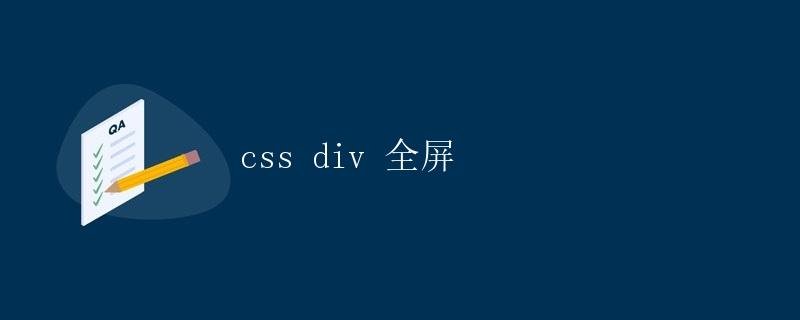CSS div full screen
CSS div fullscreen

In web design, sometimes we want to make a <div> An element fills the entire screen, making it appear fullscreen. This effect can be easily achieved with some simple CSS techniques. This article will explain in detail how to make a <div> element fill the entire screen, and provide some sample code to help you better understand.
Method 1: Using the height and width Attributes to Set Fullscreen
The simplest method is to set the <div> element’s height (height) and width (width) to 100%, making it fill the entire screen. Here is a simple sample code:
<!DOCTYPE html>
<html lang="en">
<head>
<meta charset="UTF-8">
<meta name="viewport" content="width=device-width, initial-scale=1.0">
<title>Full Screen Div</title>
<style>
body, html {
margin: 0;
padding: 0;
height: 100%;
}
.fullscreen {
height: 100vh; /* Uses viewport height as height value */
width: 100vw; /* Uses viewport width as width value */
background-color: #f0f0f0;
}
</style>
</head>
<body>
<div class="fullscreen">
This is a fullscreen div.
</div>
</body>
</html>
In the code above, we first set the height of the <body> and <html> elements to 100% to ensure that the entire page fills the screen. Next, we define a <div> element with the class name fullscreen and set its height and width to 100vh and 100vw, respectively, so that it fills the entire screen. Finally, we add a background color to this <div> element to better illustrate the effect.
Copy and paste the above code into an HTML file and open it in a browser; you will see a <div> element that fills the entire screen.
Method 2: Using the position: fixed Attribute to Fix the Element
Another method is to use the position: fixed attribute, which fixes the element’s position relative to the browser window. Here is a sample code:
<!DOCTYPE html>
<html lang="en">
<head>
<meta charset="UTF-8">
<meta name="viewport" content="width=device-width, initial-scale=1.0">
<title>Full Screen Div</title>
<style>
.fullscreen {
position: fixed;
top: 0;
left: 0;
right: 0;
bottom: 0;
background-color: #f0f0f0;
}
</style>
</head>
<body>
<div class="fullscreen">
This is a fullscreen div with fixed position.
</div>
</body>
</html>
In the code above, we define a <div> element with the class name fullscreen and set its position property to fixed. Then, we pin it to the four edges of the browser window using top: 0; left: 0; right: 0; bottom: 0; so that it fills the entire screen. Similarly, we add a background color to this <div> element to better illustrate the effect.
You can also copy and paste the above code into an HTML file and open it in a browser; you will see a <div> element with the position: fixed property that fills the entire screen.
Method 3: Using CSS Grid Layout to Achieve a Full-Screen Effect
Another common method is to use CSS Grid Layout. This is done by setting a <div> element as a Grid container, so that it fills the entire web page. Here is a sample code:
<!DOCTYPE html>
<html lang="en">
<head>
<meta charset="UTF-8">
<meta name="viewport" content="width=device-width, initial-scale=1.0">
<title>Full Screen Div</title>
<style>
body {
margin: 0;
padding: 0;
display: grid;
place-items: center;
height: 100vh;
}
.fullscreen {
background-color: #f0f0f0;
}
</style>
</head>
<body>
<div class="fullscreen">
This is a fullscreen div with CSS Grid layout.
</div>
</body>
</html>
In the code above, we set the <body> element to display: grid, making it a grid container. We then use place-items: center; to center the grid items (here, the <div> element). Finally, we set the <div> element’s height to 100vh, making it fill the entire screen. Similarly, we add a background color to the <div> element.
You can also copy and paste the above code into an HTML file and open it in a browser; you’ll see a <div> element that fills the entire screen using CSS Grid layout.
Using the above three methods, we can easily create a <div> element that fills the entire screen. Readers can choose one of the methods to achieve a full-screen effect based on their actual needs.